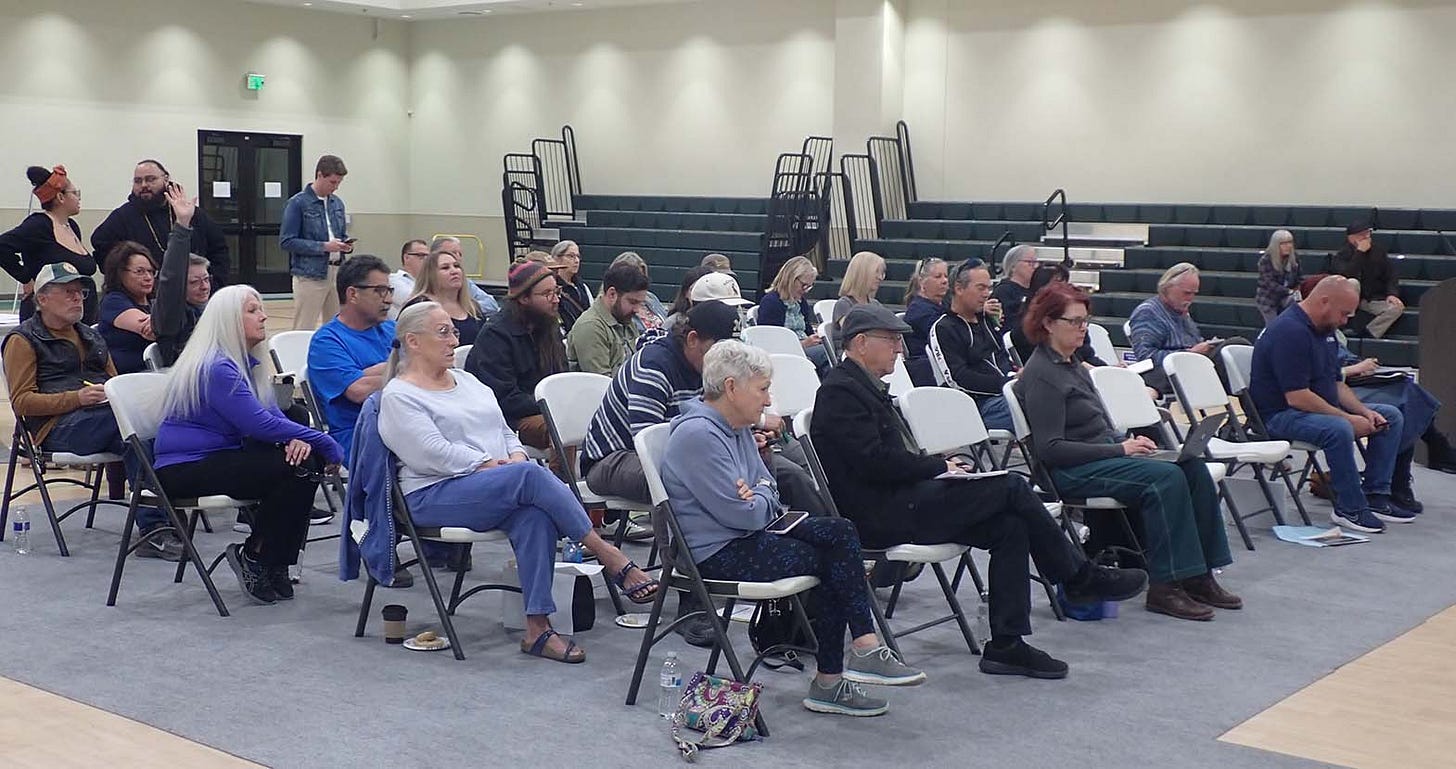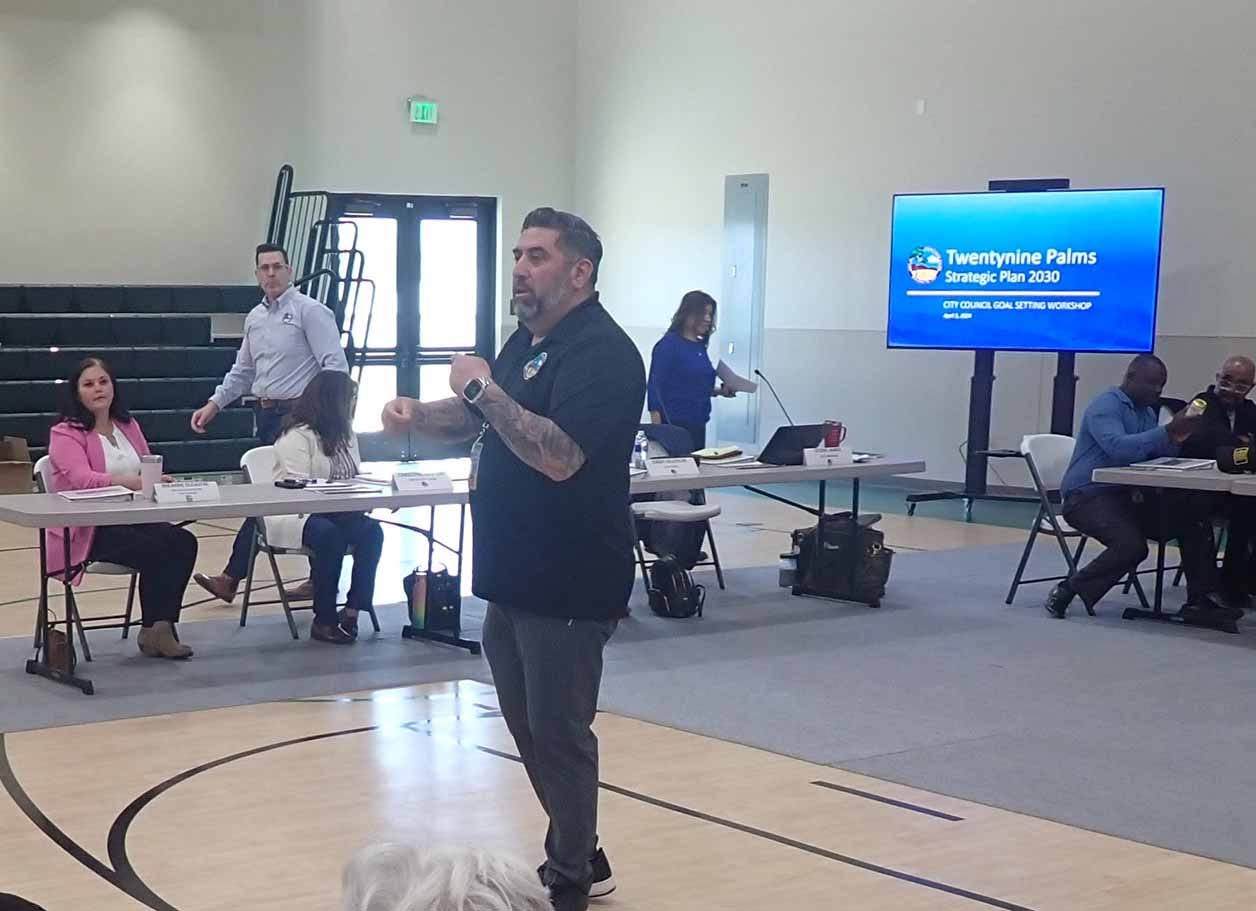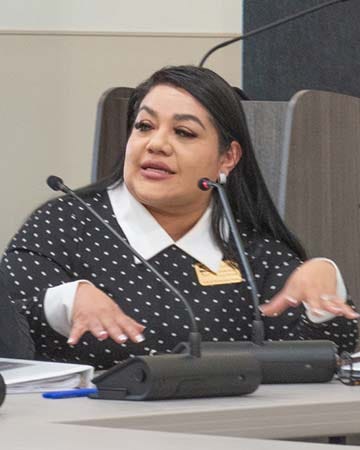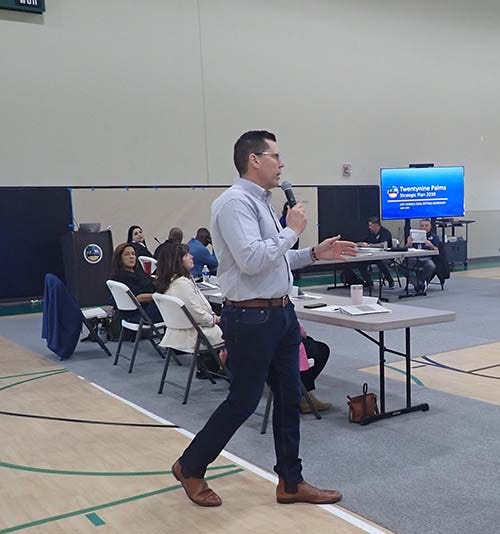City of Twentynine Palms Strategic Planning Meeting, Saturday, April 5
Economic realities threaten to shrivel the City's 20-year vision of 29 Palms as a "desert flower that bloomed"

On Saturday, April 5, Twentynine Palms’ leaders and community members took part in a five-hour workshop in the Freedom Plaza gym to figure out what the City should look like in 20 years—and how to get there. How to preserve the City’s small-town character while making more work opportunities, especially for young people, and generate revenue to balance the City’s budget? Note that we are presenting information as given and only fact checked when statements contradicted our existing reporting.
Local artists, activists, business owners, and long-time residents walked in filled with both optimism and frustration. There had been scant notice for the meeting.
Before the meeting could begin, business owner, Secretary of Rediscover 29, and Vice Chair of the Public Arts Advisory Committee (PAAC) member Sarah Lyons asked to speak:
Rediscover 29 represents over 40 local businesses, and we're really excited about the strategic planning workshop. But it's also really unfortunate timing, because this is one of the busiest weekends of the year for business owners, and most of us cannot afford to have employees in our businesses. So as you see, most of our membership is not represented because they all are running their businesses today. So it's unfortunate that so many stakeholders in the city are not able to be taking part in this workshop.
The City had pushed back the strategic planning meeting date because some staffers of Moore Iacofano Goltsman (MIG), the urban planning firm facilitating the meeting, had suffered losses in the recent Los Angeles fires. Nonetheless, 40 or so residents and business owners attended, dropping in and out of the lengthy meeting.

Where We Stand Now
Before beginning a vision exercise, City Manager Stone James reported on the City’s key assets, accomplishments, and progress in meeting the 2023 strategic planning session goals in an effort to lay a foundation for today’s planning meeting.
Progress on Strategic Planning Session 2023 Goals
James outlined progress made by the City in accomplishing 10 items from the 2023 Strategic Planning Session, which set the goals, strategies, and actions that the City was tasked to accomplish by 2025. (The Desert Trumpet recently reviewed these goals here.)
New animal shelter: Still in progress; it is “a very complex goal” (see the Desert Trumpet’s coverage of the April 4 departmental report here).
Addition of new sheriff detectives: Working to reduce case closure rates.
Ball field lights in Luckie Park: the project has been “tremendously complex “but is about 99% complete. The “quality is the same as on football fields of major universities,” James said.
Improvements for Theatre 29: on pause.
Housing and Homelessness Committee: James reported Molding Hearts has made progress in housing our homeless population.1
Events: Successfully being carried out by the Parks & Recreation department.
IT Improvements: Improving cyber-defenses against likely threats.
Debt financing to pay for major improvements: James noted that the City had borrowed money from state programs to fund projects like the ball field lighting project.
Revenue augmentation for debt financing: The City is currently looking into this as a way to fund current and future projects.
Emergency response plan: On pause due to the cost of studies to create a response plan.
City and Community Assets
James then highlighted what he called the City’s most valuable assets: the residents and the land it sits on.
I personally believe that we have some of the best people in society in our community, because they are, either are part of the [military] service or they retired from the service.2
He praised many City staff and departments, from Public Works to Human Resources to Parks and Recreation. He gave special notice to Director of Finance Abigail Hernandez-Conde, “who has been recognized in the accounting world for her work.”
He mentioned Joshua Tree National Park as an asset as one of the ten most-visited national parks in the country; “it’s a huge amenity,” he said.
James, who was Economic Development Director for Cathedral City prior to his appointment as City Manager, also said:
We have a remarkable amount of undeveloped land, and we have a community that understands that new development is required to keep the City afloat.
This assertion received the most pushback from attendees at the day’s sessions, many of whom said they wished to keep the area’s rural character and preferred to seek other sources of revenue.
Vision Exercise: City Council
Facilitator Esmeralda García read the headline from a recent Los Angeles Times story, “This desert town is brimming with new energy thanks to these 9 hip businesses.” She asked, “what will the headline be in 20 years?”
Councilmember Octavious Scott offered: “California’s rugged outback: a place for adventure.” Mayor Pro Tem Daniel Mintz said, “Still an awesome desert experience.” Mayor Steven Bilderain said, “Shines like the desert sun.” Councilmember McArthur Wright’s suggestion was “It was all possible because they believed.” Councilmember April Ramirez concluded with, “the desert flower that bloomed.”

Councilmembers emphasized the City's resilience, rooted in a deep sense of community, small-town values, and connection to the desert. They celebrated the way Twentynine Palms stands apart from larger cities—offering a sense of belonging, open dialogue, and authenticity. Councilmembers also stressed the importance of supporting local youth, fostering economic opportunity, and maintaining the City’s cultural identity.

While talking about preserving the City’s small-town feel, Councilmember Wright shared that becoming a part of a tight knit community was what made him stay in Twentynine Palms—and is what keeps him here.

While exploring how to have balanced growth, Councilmember Scott called for more economic development while being mindful not to “push people out of the City” through gentrification.

Lastly, Councilmember April Ramirez stated that she needs to see “more opportunities” for children and young people. She explained that other cities have programs teaching life skills and providing on-the-job training, suggesting that Twentynine Palms do something similar in the future.
Vision Exercise: Community Members
After the City Council wrapped up, it was community members’ turn to share their visions. They discussed balancing economic growth while preserving the City’s character; making Twentynine Palms a regional destination; preserving and promoting cultural identity; embracing our history; and supporting existing communities.
Business owner and Tourism Business Improvement District (TBID) Vice-Chair Ashton Ramsey commented:
We're lucky that we're on this peninsula where we'll always have to have the desert around us. But what do we look like? Do we look like just a junk store that sold out? Or do we look like we have very special places — special places to shop, eat, go out, that are unique, that make the place special forever. How does Carmel, California do it? How do these special places do it — they've done it. So we need to look at that. The desert experience is less pavement. Do we want to be a Walmart parking lot? Do we want to be a Walmart? Do we want to be a target? Or do we want something special? Now, there's probably a spot, you know, a space of two miles, where a lot of these things could go. I don't know where that is, but I know that driving into town and being a part of this town, we don't want to look like just a generic, you know, dump of a place that just just sold out to whatever came in.
How Twentynine Palms is framed was also a concern for many. “We need to figure out our brand. Joshua Tree has their brand,” one resident said. Short term rental owner Mary Jane Binge referred to Dr. Luckie and the City’s history as a health destination:
My headline would be Twentynine Palms caught the spirit for a unique desert experience, for health, peace and tranquility…I came here when I was a little kid because I was asthmatic and over the years, I've lost my asthma because of our clean air… We're missing an opportunity if we don't go after health retreats, maybe in the remote hot water area.

Preserving and promoting cultural identity was a concern for several local artists in particular. Local business owner, designer, and Public Arts Advisory Committee (PAAC) Chair Paul Razo said:
When these murals begin to fade, when they begin to crack, they tell a very different story to members of the community and to visitors. It is not of a city that’s on the upswing. It is a city that is crumbling simply just based off of that visual cue. We need to repair art. We need to bring more art. And I hope you understand that. A huge shout out to the Tourism Board and everything that they're doing to draw attention to this community. I think as far as beautification for the city goes, I wish the city would be (inaudible) coming down with a color palette that we would agree goes with this wilderness of the desert, and then we pitch to commercial buildings, “Would you be willing to renovate your building in this color palette?” Just to get on same page visually.
Embracing our history was a focus for Jim Bagley, grandson of a World War I veteran who moved to 29 Palms. He said we need to “honor our history” and not let Twentynine Palms become another “mega California Community:”
I'm glad to have these strategic sessions. That's why we had these multiple decisions here. It's important what we do, but it's important not to lose sight of what it means to live here.
Business owner and Rediscover 29 President Mike Usher emphasized community and families:
I'm a product of Twentynine Palms High School school system. I haven't heard us mention family at all. And I think that if we are going to be successful growing and maintaining this world 20 years from now, we need to address opportunities for our children and our families. To ignore those things will hinder everything that we'll do right.
Robin Schlosser, Director of Reach Out Morongo Basin, said:
We need to remember is we're going to have to have a safety net, because the more people you bring in, there are going to be needs. There's the nonprofits that are going to be helping to catch the people that are going to slip through the cracks, because that's that's part of society, and that's part of any community that you're going to have… You're going to have seniors that are going to be retiring, they're going to eventually need assistance, and that's something that we have to make sure that we build into this plan.
Revenue, Revenue, Revenue
After lunch, the audience, which at this point included business owners, long-time residents, and City staff, joined members of the City Council in breakout groups to outline priorities and goals for the City based on the aspirations discussed in the earlier visioning exercise.

Councilmember Ramirez presented her group’s priorities, which were a focus on an urgent care facility, financial stability for the City, improving infrastructure, communication with other elected officials at all levels, adventure-based wellness, care for and responsible ownership of animals in the community, and making Twentynine Palms a dark-sky community.
“We have a lot of ideas about financial sustainability… We want to build this, and we want to fix that road. We want to give every single department more money. We need to look for funding opportunities, not just through tourism, but also through educating our community on opportunities, on job openings, on opportunity for growth, if there’s grants, if there’s scholarships, anything we can do to have financial sustainability.”
Councilmember Scott spoke for his table, saying they ranked their priorities as revenue, housing, jobs, and safety. He said,
How do we create revenue in the City, whether it’s through a ballot measure or through other innovative ideas? It takes collaboration with our elected officials at the higher level—at the county, state, and federal level.
Robin Schlosser spoke for the third group, which also highlighted the need for revenue, recommending raising the Transit Occupancy Tax (TOT) and sales tax:
Not only is that paid for by the residents here, but by every visitor who comes here, every tourist, every person who spends a dollar in this town is going to help support our infrastructure… Community beautification would be beneficial… We need development codes that maintain the small-town feel, instead of having big developers come in and put in cookie cutter offices, or industrial parks, and box stores.
Mary Jane Binge spoke for the fourth table, pointing out services are needed for young people, such as the Girls and Boys Club. She noted that Twentynine Palms could be a healthcare destination and that there is an untapped geothermal resource. She mentioned that moving Theatre 29 downtown would help make a vibrant downtown,
Where people walk to all of our restaurants and enjoy the beautiful night sky and stars.
Ashton Ramsey and his table advocated for supporting locally owned businesses and cutting some of the barriers to operation.
One of our objectives is to pull visitors from Joshua Tree through the arts and branding. If we had an architectural review committee that could help make our neighborhoods special as they are being built while developing a commercially zoned area. Maybe there’s a good zone for fast food drive-ins, maybe closer to the Marine base.

Facilitator Esmeralda García summed up the break-out groups by saying that financial sustainability came as the audience’s top priority followed by a preservation of the City’s small-town feel and natural environment.

Regrouping, Retrenching
After more than four hours of dreaming big and sharing aspirations for Twentynine Palms, reconvening with the City Council provided a reality check. Mayor Bilderain led the discussion:
Two years ago, we discussed using debt financing for major improvements and the need for sustainable revenue. That conversation is more urgent than ever. Our current path isn’t sustainable. Like many cities, we need to consider a 1% sales tax increase—matching Yucca Valley and others already at 9.5–11%. Our TOT is the lowest in the area, yet visitors heavily use our roads and facilities. Increasing TOT and sales tax would help fund needed improvements—like flood control, school access, and projects like the Sullivan and Hatch road widening.
He also said that the City needs funding for law enforcement staffing, the animal shelter, and future expansions. Without new revenue, the City risks service cuts, he said: “If the state shifts financial burdens to counties and cities again, we must be prepared—or we’ll be left making tough cuts.”
All of the City Council members are veterans, military retirees, or military dependents and the Mayor said that 10% of the local population are retired military or veterans, 3% higher than the national average—and yet few mental health and medical facilities are available closer than 90 minutes away. He noted that housing is a particular challenge for this community. He hoped for better services for local military.
Each of the Councilmembers responded, highlighting the need for revenue and maintaining and improving infrastructure. Councilmember Scott reiterated the importance of housing:
Housing is critical and should be a top priority; we're mandated to build 1,000 homes by 2030. While infrastructure like sewers matters, housing is the immediate need. The animal shelter and theater also deserve focus—both support community well-being and tourism, which can boost city revenue.
Councilmember Ramirez emphasized education:
We empower people through knowledge—like the saying, “Teach a man to fish, and he’ll eat for a lifetime.” Education creates generational wealth. Someone suggested we frame this as community empowerment through education, which I loved… We can help by offering workshops—on topics like FAFSA [Federal Student Aid], CPR, or City procedures—using local experts like school counselors, nurses, or deputies. Our community naturally comes together in times of need, and we should build on that strength through shared learning.
She also spoke to derelict housing and City Manager James took up the thread, saying that the City has absentee landowners who sometimes don’t know they own property here and that the process of taking over derelict properties needs to be accelerated.
Public Comment
The public weighed in on issues that stood out as important for them, such as health care, education, and housing. Anna Stump, a trustee for Copper Mountain College, said the College is an “amazing, vibrant place,” and an underused resource.
Jim Bagley advocated for improved code enforcement. As a real estate broker, he noted the signs of an economic downturn including rising foreclosures and urged action to prevent urban decay. He was also concerned about short-term rentals, disruptive lighting, and vandalism.
Code enforcement is not responsive. Short-term rentals have changed my life, I am surrounded by them and nothing annoys me more than music blasting at three in the morning played by people who don’t live here… It took 90 days to get a resolution for an industrial light glaring from the yard of an STR. We have some innovative new businesses in town but if you let other buildings deteriorate, you are doing nothing for the quality of life.
He stressed that improving livability for residents—not just visitors—requires creating opportunities, maintaining properties, and investing in innovative businesses rather than solely increasing taxes.
George Mulopulos, who owns Proactive Properties LLC, which has large landholdings in Twentynine Palms, said:
I’ve heard the need for increased City revenue discussed, including ideas like raising sales or property taxes, which are straightforward but not the only options. For example, increasing STR usage could boost TOT (Transient Occupancy Tax) revenue. Projects like the Ofland Resort and the solar field could also bring in revenue. I’d like the City Council to quantitate all potential revenue sources—how much each option (like tax increases or new developments) would contribute. This comparison would allow for more informed decision-making based on data, not just ideas. I simply want to see the numbers.
City Manager James thanked all the participants. He reminded the audience that in addition to faltering revenue, “we’re up against unfunded mandated regulations from the state of California.” He also noted that the City and Water District are working on a USGS study that identifies the location of groundwater and that the District will be in on planning sessions.
James said the strategic planning process would continue through June, and to look for a QR code that links to a survey that would provide additional valuable input.
Leave your thoughts in the comments below. Please note that we do not allow anonymous comments. Please be sure your first and last name is on your profile prior to commenting. Anonymous comments will be deleted.
Feel free to share this article!
We have reached our goal of $5,000 in paid subscriptions! We are very grateful for support from our community. We know that many communities in the Morongo Basin are economically disadvantaged, so our coverage will always be free. However, if you have the means to support our work, we always appreciate upgrades to a paid subscription. Your upgrade helps keep subscriptions free for those who cannot afford to donate.
Note: Your subscription/donation will be listed as AHA Projects, the name of our fiscal receiver, on your statement.
The City Manager implied that the Housing and Homeless Committee made the connection to Molding Hearts. However, the referral appears to have come through Councilmember April Ramirez.
It’s not clear how many residents of the City have military connections. Around 20,000 people live on the Marine base, from a cohort 12,500 active duty personnel, 24,000 family members, and another 21,000 Department of Defense employees and contractors. Mayor Bilderain said later in the meeting that 10% of City’s population of 28,000 consists of retired military or veterans — the population number he quoted includes the on-Base barracks. While many people in 29 have military connections, not everyone does.



